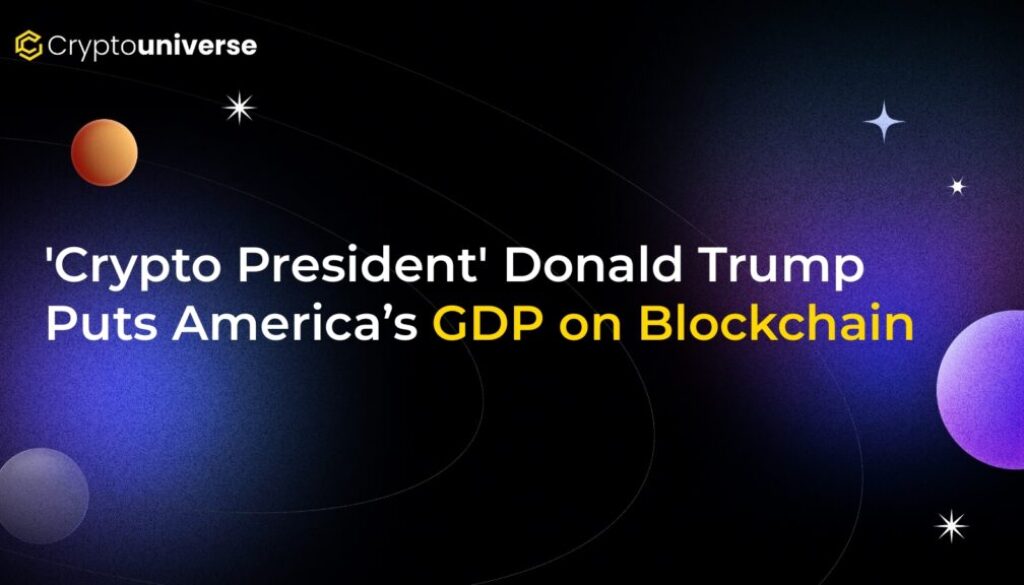‘Crypto President’ Donald Trump Puts America’s GDP on Blockchain

A Historic Leap for Crypto: US GDP Data is Now On-Chain
In a move that solidifies his moniker as the “Crypto President,” Donald Trump’s administration has taken a groundbreaking step by publishing official U.S. economic data directly onto public blockchains. The U.S. Department of Commerce announced that key figures from the nation’s Gross Domestic Product (GDP) report are now recorded on multiple distributed ledgers, marking a pivotal moment for both government transparency and the mainstream adoption of blockchain technology.
This isn’t a drill or a pilot program. The most-watched economic indicator in the world is now verifiable, immutable, and accessible on chains like Bitcoin and Ethereum. Let’s break down what happened, how it was done, and why this could permanently reshape the relationship between governments, markets, and the digital economy.
What Exactly Was Put on the Blockchain?
On Thursday, Commerce Secretary Howard Lutnick unveiled the initiative, framing it as a way of “making America’s economic truth immutable and globally accessible like never before.” The department didn’t just upload a file; they strategically placed two key pieces of information on-chain:
- The Top-Line GDP Figure: The headline number from the latest report — 3.3% annual growth for the second quarter — was published as a direct data point.
- A Digital Fingerprint of the Report: The department calculated a SHA-256 hash of the official PDF report. This unique cryptographic signature acts as a tamper-proof seal. Anyone can now verify that their copy of the GDP report is the original, unaltered version by comparing its hash to the one recorded on the blockchain.
This data wasn’t confined to a single network. In a demonstration of interoperability, the information was broadcast across nine major public blockchains, including:
- Bitcoin
- Ethereum
- Solana
- Avalanche
- Polygon PoS
- Arbitrum One
- Optimism
- TRON
- Stellar
The Tech Powering the Move: Oracles and Exchanges
Bringing real-world data onto a blockchain requires specialized technology. The Commerce Department collaborated with key players in the crypto ecosystem to make this happen.
Blockchain oracles, which act as secure bridges between off-chain data and on-chain smart contracts, were essential. Industry leaders Chainlink and Pyth played a crucial role in gathering the GDP data and broadcasting it accurately across the nine different networks.
Furthermore, major U.S.-based cryptocurrency exchanges, including Coinbase, Gemini, and Kraken, assisted in the process, lending their infrastructure and credibility to the landmark initiative.
Why Now? The Political Drive for Immutable Data
While the technological leap is significant, the motivation behind it is deeply rooted in politics. The move is seen as a direct response to President Trump’s vocal skepticism of economic figures published by federal agencies.
Last month, frustrations mounted after the Bureau of Labor Statistics (BLS) released lower-than-expected job numbers, leading to the dismissal of the bureau’s head. By placing Commerce Department data on an immutable ledger, the administration aims to build trust and present the figures as unchangeable and transparently verifiable, free from accusations of political manipulation.
As Secretary Lutnick stated, this initiative helps “cement our role as the blockchain capital of the world,” while adding, “And everybody has to admit that 3.3% GDP growth is impressive.”
Why This is a Game-Changer for Crypto and Beyond
The implications of this single act are massive and extend far beyond a simple press release. Here’s why it matters:
- Unprecedented Government Validation: The U.S. government is actively using public blockchain infrastructure for a core function. This is the strongest signal of validation the crypto industry has ever received, potentially paving the way for clearer regulations and wider institutional acceptance.
- A New Era for DeFi: Decentralized Finance (DeFi) protocols rely on accurate, real-world data. With official U.S. GDP figures now on-chain, developers can build more sophisticated financial products, such as decentralized prediction markets, stablecoins pegged to economic growth, or novel insurance contracts, all based on a tamper-proof data source.
- Enhanced Transparency and Trust: By making economic data public and immutable, the government is setting a new standard for transparency. Citizens and market participants can independently verify official figures, reducing reliance on intermediaries and fostering greater trust in public institutions.
- A Global Precedent: The United States has fired the starting gun. Other nations will now be watching closely, and likely following suit. We may be on the cusp of a global trend where critical government data—from inflation rates to election results—is secured on the blockchain.
The Road Ahead for the ‘Crypto President’
This move aligns perfectly with Donald Trump’s increasingly pro-crypto rhetoric, including sensational statements about using crypto to tackle the national debt. While some comments are more political theater than policy, this action is a concrete step that demonstrates a genuine commitment to leveraging blockchain technology.
By putting America’s


